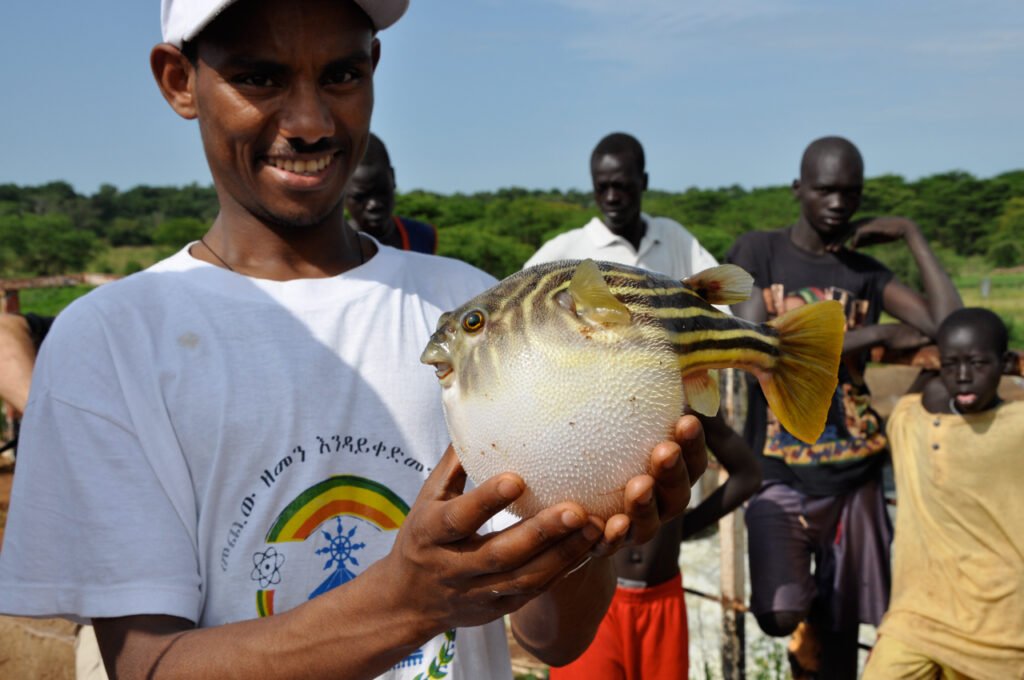Fahaka Puffer Fish: Guide to Keeping

Fahaka Puffer Fish: The Ultimate Guide to Keeping These Fascinating Aquatic Oddities
Fahaka Puffer Fish: The Ultimate Guide to Keeping These Fascinating Aquatic Oddities
Fahaka Puffer Fish Care Guide: Tank Setup, Diet, Behavior & More
Fahaka Puffer Fish, Tetraodon lineatus, puffer fish care, freshwater puffer, aquarium setup, diet, tank size, water parameters, behavior, tank mates, feeding, lifespan
Discovering the Enigmatic Fahaka Puffer Fish
Fahaka Puffer Fish (Tetraodon lineatus), also known as the Nile Puffer or Striped Puffer, are one of the most intriguing and captivating freshwater fish in the aquarium hobby. Native to the Nile River basin in Africa, these unique fish are known for their distinctive appearance, intelligent behavior, and powerful personalities. With their endearing expressions and entertaining antics, Fahaka Puffer Fish have captured the hearts of many aquarists looking for a truly unforgettable aquarium inhabitant.
In this comprehensive guide, we will explore the fascinating world of Fahaka Puffer Fish, delving into their natural history, care requirements, and the joys and challenges of keeping these incredible fish in the home aquarium. Whether you are an experienced aquarist seeking a new challenge or simply captivated by the charm of these aquatic oddities, read on to discover everything you need to know about successfully keeping and appreciating Fahaka Puffer Fish.

Quick Facts
- Scientific Name: Tetraodon lineatus
- Common Names: Fahaka Puffer Fish, Nile Puffer, Striped Puffer
- Adult Size: 30-43 cm (12-17 inches)
- Life Expectancy: 10-15 years
- Origin: Nile River basin in Africa
- Temperament: Aggressive, territorial
- Tank Level: Middle to bottom
- Minimum Tank Size: 200-400 liters (55-100 gallons)
- Diet: Carnivorous, preference for hard-shelled foods
- Breeding: Rarely bred in captivity
- Water Temperature: 24-28°C (75-82°F)
- pH Range: 7.0-8.0
- Water Hardness: 10-20 dGH
- Difficulty: Advanced
- Compatibility: Should be kept alone or with very careful consideration
Unveiling the Mysterious Appearance
One of the most striking features of Fahaka Puffer Fish is their unique and captivating appearance. These fish have a rounded, elongated body covered in a pattern of dark stripes against a lighter background, which can range from tan to yellow-green. Their bellies are typically white or cream-colored, creating a stunning contrast with their patterned backs.
As with other puffer fish species, Fahaka Puffer Fish have the ability to inflate their bodies by taking in water or air when threatened, making them appear much larger and more intimidating to potential predators. This fascinating defense mechanism, combined with their powerful beak-like teeth, has earned puffer fish a reputation as one of the most formidable and intriguing fish in the aquatic world.
Exploring the Natural Habitat
Fahaka Puffer Fish are native to the Nile River basin in Africa, where they inhabit a variety of freshwater environments including rivers, lakes, and floodplains. In their natural habitat, these fish can be found in areas with sandy or muddy substrates, often near submerged vegetation or other structures that provide cover and hiding spots.
The water in their native range is typically warm and slightly alkaline, with temperatures ranging from 24-28°C (75-82°F) and a pH of 7.0-8.0. The water hardness in these habitats is generally moderate to high, ranging from 10-20 dGH.
Understanding the natural habitat of Fahaka Puffer Fish is essential for replicating their ideal living conditions in the home aquarium. By providing a spacious tank with appropriate water parameters, substrate, and décor, aquarists can create a captivating and enriching environment that allows these remarkable fish to thrive and showcase their unique behaviors.

Demystifying Fahaka Puffer Fish Behavior
Fahaka Puffer Fish are known for their intelligent, curious, and often mischievous nature. These fish have a strong personality and can be highly interactive with their owners, learning to recognize and even beg for food. They are active swimmers and explorers, constantly investigating their surroundings and engaging with their environment.
However, Fahaka Puffer Fish are also highly territorial and aggressive, particularly towards other fish. In the wild, they are solitary predators, and this instinct carries over into the aquarium setting. They are best kept alone or with very carefully selected tank mates that can withstand their aggressive tendencies and are too large to be considered prey.
When threatened or agitated, Fahaka Puffer Fish will not hesitate to use their powerful teeth and jaws to defend themselves or their territory. They are known for their ability to crush and consume hard-shelled prey items like snails and shellfish, and their bite can cause serious injury to other fish or even unwary aquarists.
Understanding and respecting the complex behavior of Fahaka Puffer Fish is crucial for providing them with a suitable living environment and ensuring the safety and well-being of both the puffer fish and any potential tank mates. By creating a spacious, well-structured aquarium and being mindful of their territorial nature, aquarists can enjoy the fascinating and rewarding experience of keeping these intelligent and captivating fish.
Creating the Perfect Fahaka Puffer Fish Aquarium
When setting up a home for your Fahaka Puffer Fish, it is essential to provide a spacious and well-maintained aquarium that caters to their specific needs. As a general rule, a single Fahaka Puffer Fish requires a minimum tank size of 200-400 liters (55-100 gallons), depending on the individual’s size and level of aggression.
The aquarium should have a tight-fitting lid or cover to prevent these powerful jumpers from escaping, as well as to maintain good water quality and minimize evaporation. A strong filtration system is necessary to keep the water clean and well-oxygenated, as Fahaka Puffer Fish are sensitive to poor water conditions and can quickly succumb to illness in an unhealthy environment.
When choosing a substrate for your Fahaka Puffer Fish tank, opt for a soft, sandy bottom that will not scratch their delicate skin as they explore and forage. Provide plenty of hiding spots, caves, and swim-throughs using rocks, driftwood, or PVC pipes to create a stimulating and engaging environment that allows your puffer fish to express their natural behaviors.
Live plants can be a beautiful addition to a Fahaka Puffer Fish aquarium, but it is important to choose hardy, fast-growing species that can withstand the occasional nibbling or uprooting. Floating plants like Hornwort or Water Lettuce can be a good option, as they provide shelter and shade while being easily replaced if damaged.
Maintaining excellent water quality is crucial for the health and well-being of your Fahaka Puffer Fish. Regular water changes of 10-20% per week, along with monitoring of ammonia, nitrite, and nitrate levels, will help keep your puffer fish happy and thriving. Be sure to use a high-quality water conditioner to remove harmful chemicals and heavy metals from tap water before adding it to the aquarium.
By creating a spacious, well-structured, and properly maintained aquarium, you can provide your Fahaka Puffer Fish with a comfortable and enriching home that supports their unique needs and showcases their captivating behaviors.

Mastering the Fahaka Puffer Fish Diet
In the wild, Fahaka Puffer Fish are opportunistic predators that feed on a variety of hard-shelled invertebrates, including snails, clams, and crustaceans. Their strong, beak-like teeth and powerful jaws are specially adapted for crushing and consuming these tough prey items, and their diet plays a crucial role in maintaining their dental health and overall well-being.
When keeping Fahaka Puffer Fish in the home aquarium, it is essential to provide a varied and nutritious diet that mimics their natural feeding habits. The foundation of their diet should consist of high-quality, meaty foods like shellfish, crustaceans, and mollusks, which can be offered in the form of live, frozen, or freeze-dried items.
Some excellent food options for Fahaka Puffer Fish include:
- Live or frozen snails (e.g., Mystery Snails, Ramshorn Snails)
- Live or frozen clams, mussels, and oysters
- Frozen or freeze-dried krill, shrimp, and crayfish
- Frozen or freeze-dried squid and octopus
- Hard-shelled insects like crickets or beetles (occasionally)
It is important to note that Fahaka Puffer Fish have a relatively slow metabolism, and overfeeding can lead to obesity and other health issues. Adult puffer fish should be fed 2-3 times a week, with each meal consisting of an amount that can be consumed within 5-10 minutes. Juvenile fish may require more frequent feedings to support their rapid growth and development.
In addition to their regular diet, Fahaka Puffer Fish need hard, crunchy foods to help wear down their continuously growing teeth. Providing snails or other hard-shelled items with every meal will ensure that your puffer fish’s teeth remain healthy and properly trimmed.
By offering a diverse and well-balanced diet that focuses on hard-shelled, meaty foods, you can keep your Fahaka Puffer Fish healthy, active, and thriving in the home aquarium. Always be sure to remove any uneaten food after each feeding to maintain good water quality and prevent the growth of harmful bacteria or algae.
Navigating Fahaka Puffer Fish Tank Mates
Due to their highly territorial and aggressive nature, Fahaka Puffer Fish are best kept as solitary specimens in a species-specific aquarium. They are not well-suited for community tanks and will often harass, injure, or even kill other fish that they perceive as a threat or competition for resources.
In some cases, experienced aquarists may successfully keep Fahaka Puffer Fish with very carefully selected tank mates that are too large to be considered prey and can withstand the puffer’s aggressive tendencies. However, this is a risky approach that requires constant monitoring and a thorough understanding of each species’ behavior and compatibility.
If you are considering keeping your Fahaka Puffer Fish with other fish, some potentially compatible tank mates might include:
- Other large, aggressive puffer fish species (with extreme caution)
- Large, fast-moving fish like Bala Sharks or Silver Arowanas
- Massive, armored fish like Sailfin Plecos or Ripsaw Catfish
It is crucial to remember that even with carefully selected tank mates, there is always a risk of aggression or injury when keeping Fahaka Puffer Fish in a shared aquarium. It is generally recommended to err on the side of caution and provide these unique fish with a dedicated, species-specific tank where they can thrive without the stress and potential dangers of cohabitation.
If you do choose to attempt a community setup, be sure to provide a very large aquarium with plenty of hiding spots, visual barriers, and territory for each fish. Monitor the behavior of your Fahaka Puffer Fish and their tank mates closely, and be prepared to separate them if necessary to ensure the safety and well-being of all the inhabitants.
The Challenges of Breeding Fahaka Puffer Fish
Breeding Fahaka Puffer Fish in captivity is a rare and challenging endeavor that has only been achieved by a handful of dedicated experts and institutions. In the wild, little is known about the reproductive habits of these fish, making it difficult to replicate the necessary conditions for successful breeding in the aquarium setting.
One of the main challenges in breeding Fahaka Puffer Fish is identifying the sex of the fish, as there are no reliable external indicators of gender. Some aquarists have reported that males may have a slightly larger and more elongated body shape compared to females, but this is not a definitive method of sexing.
In the few successful breeding attempts documented, Fahaka Puffer Fish have been observed engaging in elaborate courtship rituals, with the male pursuing the female and displaying his puffed-up body and extended fins. The female will lay adhesive eggs on a flat surface, which the male then fertilizes and guards until hatching.
Rearing the delicate fry is another significant challenge, as they require pristine water conditions and a steady supply of tiny live foods like rotifers and infusoria. As the fry grow, they must be carefully transitioned to larger live foods and eventually weaned onto a diet of hard-shelled invertebrates to support their proper development.
Due to the numerous difficulties and uncertainties involved in breeding Fahaka Puffer Fish, it is a task best left to experienced professionals with the knowledge, resources, and dedication to attempt this fascinating but complex endeavor. For the vast majority of aquarists, the focus should be on providing a healthy, enriching, and well-maintained environment for their adult Fahaka Puffer Fish to thrive and showcase their unique personalities.
Knowing When You’re Ready for a Fahaka Puffer Fish
Keeping Fahaka Puffer Fish is a rewarding but challenging undertaking that requires a significant level of experience, knowledge, and commitment. These unique fish have complex needs and behaviors that must be carefully considered before deciding to bring one into your home aquarium.
Some key factors to consider when determining if you are ready for a Fahaka Puffer Fish include:
- Experience level: Fahaka Puffer Fish are not recommended for beginners due to their specific care requirements and aggressive temperament. It is important to have a solid understanding of aquarium maintenance, water chemistry, and fish behavior before attempting to keep these fish.
- Tank size and setup: Fahaka Puffer Fish require a spacious, well-maintained aquarium with appropriate water parameters, filtration, and décor. Be sure you have the resources and space to provide a suitable home for your puffer fish before making the commitment.
- Time and dedication: Caring for a Fahaka Puffer Fish involves regular water changes, monitoring of water quality, and providing a varied and nutritious diet. Make sure you have the time and willingness to dedicate to the ongoing care and maintenance of your puffer fish.
- Long-term commitment: With a lifespan of 10-15 years or more, Fahaka Puffer Fish are a long-term responsibility. Consider your future plans and ability to provide a stable, healthy environment for your puffer fish throughout their life.
- Compatibility with your current setup: If you have an existing aquarium with other fish, carefully research the compatibility of Fahaka Puffer Fish with your current inhabitants. In most cases, it is best to dedicate a separate, species-specific tank for your puffer fish to avoid aggression and ensure the well-being of all your aquatic pets.
By honestly assessing your experience, resources, and commitment, you can determine whether you are ready to take on the joys and challenges of keeping a Fahaka Puffer Fish. When you are prepared to provide these fascinating fish with the care and dedication they require, you will be rewarded with a truly unique and engaging aquarium inhabitant that will captivate and inspire you for years to come.
Views: 4





